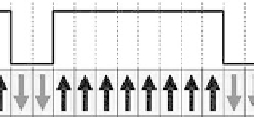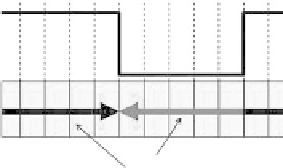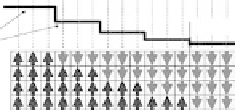Information Technology Reference
In-Depth Information
Signal
1
0000
1
0
1
01
0
0
0
M
(a)
(b)
0
1
2
3
4
Signal
Adjacent levels
5 dBm
(c)
Figure
6.1.
A binary signal representation with a trivial FM encoding in
(a) longitudinal and (b) perpendicular recording modes. (c) A trivial example
of a system with multilevel data encoding.
below in more detail, the main concern is to engineer a magnetic recording system
which could maintain signal-to-noise ratio (SNR) between any two adjacent levels
sufficient for a data encoding channel to maintain a certain data bit error rate. The
novel multilevel data coding methods discussed in this chapter are designed to deal
with SNR of approximately 5 dB. Therefore, it is clear that with the goal to
develop a practical ML recording system with as many levels as possible, it is
necessary to engineer a magnetic recording system with as many signal levels as
possible and at least 5 dB SNR between any two adjacent levels. It is expected that
the magnetic system discussed in this chapter could use at least twenty ''distin-
guishable'' signal levels. Finally, it should be mentioned that the ML approach
could be applied ideally to any of the above mentioned alternative technologies to
further increase the data capacity.
6.2.2. History of Multilevel Optical Recording
Before exploring the feasibility of ML magnetic recording, it may be helpful to
learn from the experience of other industries with regard to ML data coding. For
example, in 2004, LSI Logic, one of the electronics giants, acquired Calimetrics,
the first company to focus on the development of a multilevel optical recording
system for CD or DVD technologies. Though Calimetrics ceased to exist mostly
because of the sudden increase in popularity of writable DVD technology, it was
successful in introducing a multilevel signal standard to the world of information
related technologies, especially overseas. Today, it is becoming normal for new









Search WWH ::

Custom Search